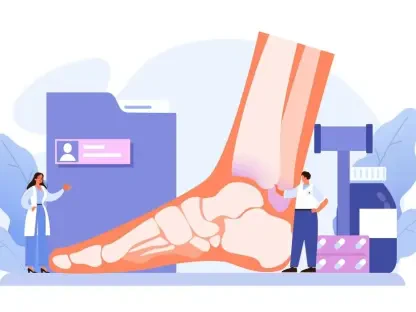The Union Budget 2025, presented by Finance Minister Nirmala Sitharaman, has placed a significant emphasis on healthcare, aiming to address the critical needs of millions of Indians. Despite incremental increases in healthcare spending over the past decade, India still falls short of the National Health Policy (NHP) 2017 recommendation that public health expenditure should account for 2.5 percent of GDP. This budget aims to prioritize healthcare, but does it effectively address the sector’s pressing needs?
Health Budget Allocation and Investment
Incremental Increases and Persistent Underinvestment
The government allocated INR 95,957.87 crore to the healthcare sector for FY26, marking a 9.46 percent increase from FY25. However, this figure still represents only 1.94 percent of the total budget, signaling continued underinvestment. This allocation diverges from the NHP 2017 recommendations, which envisioned directing two-thirds of the health budget toward primary healthcare. Currently, only around 40 percent goes towards this segment, with the National Health Mission (NHM) seeing a declining share within the health budget over the last five years.
This shift in allocation is troublesome because emphasizing tertiary care over primary healthcare undermines the early detection and prevention of diseases. Such early intervention methods typically reduce the heavy burden on tertiary care facilities. If primary healthcare remains underfunded, communities suffer from a lack of accessible preventative care, leading to more severe health issues requiring advanced treatment. Health experts argue that strengthening primary healthcare is essential for creating a robust healthcare infrastructure capable of managing both common ailments and outbreaks of public health emergencies more effectively.
Focus on Tertiary Care Over Primary Healthcare
Despite the necessity of investing in primary healthcare, the budget’s structure reveals a preference for tertiary care investments. This trend is concerning as primary healthcare is crucial for catching and managing diseases early, which can significantly mitigate the load on tertiary care facilities in the long run. Primary healthcare centers, typically the first point of contact for the majority of the population, are imperative for routine check-ups, vaccinations, and early-stage medical interventions.
However, the declining funding share for National Health Mission (NHM) over the last five years signifies a persistent tilt toward tertiary healthcare endeavors. While advanced medical facilities are essential, neglecting the foundational healthcare layer hinders overall efficiency and effectiveness. The situation also highlights the need for a balanced approach in healthcare expenditure to provide comprehensive coverage that includes preventive care, early diagnosis, and advanced treatments. Addressing this imbalance is crucial for creating a resilient healthcare system.
Ayushman Bharat Schemes
Expansion and Increased Funding
The Ayushman Bharat Pradhan Mantri Jan Arogya Yojana (AB PM-JAY) received INR 9,406 crore, a 29 percent increase from last year’s budget. This rise in funding underlines the policy’s recent expansion, now covering the entire 70+ population. Additionally, the Pradhan Mantri Ayushman Bharat Health Infrastructure Mission (PMABHIM) was granted INR 4,200 crore, marking an impressive 40 percent increase from the previous year’s allocation. These substantial allocations are meant to improve healthcare infrastructure and facilitate better access to healthcare services for older demographics.
Increasing allocation to schemes like AB PM-JAY and PMABHIM is a positive step towards enhancing healthcare access and infrastructure. However, the effectiveness of these schemes will largely depend on their implementation. Effectively reaching the intended beneficiary groups, particularly the vulnerable and elderly sections of the population, requires robust administrative mechanisms and transparency. Additionally, ensuring quality care and preventing misuse or fraud are equally important measures that need to be incorporated for the schemes to have a meaningful impact on healthcare outcomes.
Impact on Healthcare Access
These increased allocations are expected to enhance healthcare access for the elderly and improve health infrastructure nationwide. Yet, the success of these expansions hinges on practical implementation details, which include streamlined processes and oversight. Effective implementation ensures that resources reach the most vulnerable segments of society, addressing rural-urban healthcare disparities, and promoting equity in access to medical services.
Ensuring quality care and tackling issues such as fraud are paramount for sustaining the credibility and efficiency of these healthcare schemes. The expansion of AB PM-JAY, while a commendable step, must be accompanied by strict regulatory frameworks and continuous monitoring to ensure it serves the public effectively. Without these safeguards, the increased budget allocations might not translate into tangible healthcare benefits on the ground, and the overall objective of providing affordable and accessible healthcare to all might remain unfulfilled.
Taxation and Financial Incentives
Missed Opportunities in GST Reforms
The Union Budget 2025 missed a significant chance to implement a unified 5 percent GST on all healthcare goods and services. Such a reform could have reduced input costs for hospitals and medical providers, thereby making healthcare more affordable for the general population. Instead, the continued presence of fragmented tax structures and relatively high GST rates on essential medical products adds to the financial burden placed on the healthcare sector. This persistent issue hinders the overall goal of making healthcare accessible and affordable for all.
High GST rates on medical products not only inflate healthcare costs for providers but also increase out-of-pocket expenses for patients. Streamlining GST rates could alleviate some of these financial pressures, fostering a more conducive environment for effective healthcare delivery. Financial analysts have long advocated for simplified tax regimes in healthcare to ensure that essential medical services remain within reach for a broader demographic. The failure to address these concerns in the latest budget reveals an area that requires urgent policy intervention.
Health Insurance and Tax Deductions
Despite the rising costs of healthcare, the penetration of health insurance in India remains low, particularly among the middle class and informal sector workers. The budget did not address anticipated measures such as reducing GST on health insurance premiums from 18 percent to 5 percent or increasing the tax deduction limit under Section 80D from INR 25,000 to INR 50,000. These measures could have significantly increased health insurance coverage and provided greater financial protection for families dealing with health emergencies.
Lower GST on health insurance premiums could make policies more affordable, encouraging more families to obtain coverage. Increasing the Section 80D tax deduction limit would further incentivize individuals to invest in health insurance, thus expanding the safety net for more citizens. The absence of these financial incentives means that significant portions of the population, particularly those in vulnerable and middle-income groups, remain unprotected against high medical costs. Addressing these gaps in future budgets could significantly bolster India’s healthcare coverage and financial security for its citizens.
Health Infrastructure, Medical Education, and Digital Health
Investments in Hospital Capacity and Workforce Expansion
The budget includes substantial investments in hospital capacity, beds, disease surveillance, and workforce expansion, with the NHM receiving INR 37,226.92 crore. Among the notable announcements was the establishment of 200 cancer centers in FY26 and the facilitation of daycare cancer centers in district hospitals over the next three years. These investments are aimed at improving healthcare infrastructure and addressing the growing burden of non-communicable diseases (NCDs) such as cancer, which requires specialized care and treatment facilities.
Strengthening healthcare infrastructure is critical for tackling the rising tide of NCDs, which now account for a significant portion of India’s disease burden. Establishing specialized centers and expanding capacity is a step in the right direction, albeit one that needs to be complemented by adequate staffing and training for healthcare personnel. Investing in these facets of healthcare ensures not only the readiness of the system to handle increasing patient loads but also enhances the overall quality of care provided. However, this effort requires sustained and comprehensive initiatives beyond initial funding to achieve long-term benefits.
Enhancements in Medical Education
Medical education also saw significant attention, with plans to add 10,000 additional medical seats in the coming year and a goal of adding 75,000 seats over the next five years. These measures aim to address the shortage of healthcare professionals and improve the quality of medical education in India. Increasing the number of medical seats is expected to balance the demand and supply of trained doctors, nursing staff, and other healthcare professionals, which is essential for sustaining an efficient healthcare system.
Enhancing medical education contributes to building a strong pipeline of future healthcare practitioners who are both qualified and capable of dealing with emerging health challenges. This focus on medical education underscores the government’s commitment to empowering the next generation of medical professionals. However, it is equally important to ensure that the quality of education keeps pace with the increase in capacity. Adequate infrastructure, experienced faculty, and a robust curriculum are crucial for producing competent and well-prepared healthcare professionals.
Digital Health Initiatives
The ‘Heal in India’ program, aimed at boosting medical tourism, includes initiatives such as streamlining visa processes and partnering with the private sector. While these steps are promising, the detailed concrete actions required to ensure the program’s success and attract international patients remain to be seen. The digital health initiatives contained in the budget are crucial for modernizing India’s healthcare system and leveraging technology to improve service delivery and operational efficiency.
The digital health initiatives, if executed well, can transform how healthcare is accessed and provided. Streamlining visa processes for medical tourists, for instance, can position India as a preferred destination for affordable and high-quality medical care. Moreover, partnerships with the private sector can lead to innovations in healthcare delivery systems, further enhancing patient experiences and outcomes. The success of such initiatives, however, relies on coordinated efforts and sustained commitment to digital transformation in healthcare.
Pharmaceutical and MedTech Industry
Exemptions and Incentives
The budget exempted 36 life-saving drugs from Basic Customs Duty (BCD) and added 37 new medicines, along with 13 patient assistance programs, to the list. These measures are aimed at promoting the affordability and accessibility of essential medicines, crucial for treating critical ailments. The Production Linked Incentive (PLI) scheme for pharmaceuticals received INR 2,445 crore to strengthen domestic manufacturing of Active Pharmaceutical Ingredients (APIs) and MedTech products, reinforcing the “Make in India” initiative in the healthcare sector.
These exemptions and incentives are steps in the right direction to make essential medicines more affordable and enhance the domestic pharmaceutical industry’s capability. By focusing on local manufacturing of APIs, the budget aims to reduce dependency on imports, thereby securing a more stable supply chain for critical drugs. Moreover, these incentives can potentially boost innovation, leading to more homegrown solutions in healthcare. However, ensuring these policies translate into tangible impacts on the ground involves sustained policy measures and support from both the public and private sectors.
Unmet Requests for Broader Financial Incentives
Despite these positive steps, broader financial incentives that the pharmaceutical and MedTech industries had requested remained unmet. Weighted tax deductions for research and development (R&D) are crucial for accelerating drug discovery and boosting pharmaceutical exports. Industry stakeholders have long advocated for heightened financial support to spur innovation and maintain competitiveness in the global market. Addressing these requests comprehensively would have fostered a more conducive environment for medical breakthroughs and advancements in healthcare technology.
The omission of additional financial incentives for R&D underlines a missed opportunity to galvanize the industry further. Sustained investment in R&D is pivotal for fostering a resilient and self-reliant pharmaceutical sector, capable of introducing pioneering treatments and medications. A stronger focus on financial incentives could have spurred groundbreaking research, ultimately benefiting patients by providing access to novel therapies and improved health outcomes. Future budget considerations must encompass these aspects to fully realize India’s potential as a healthcare innovation hub.
Conclusion and Final Thoughts
The Union Budget 2025, introduced by Finance Minister Nirmala Sitharaman, has a strong focus on healthcare with the goal of meeting the dire needs of millions of Indians. Over the last ten years, there have been gradual increases in healthcare spending, but these have been insufficient to meet the targets set by the National Health Policy (NHP) 2017. According to the NHP, public health expenditure should be 2.5 percent of the GDP, a benchmark India has yet to reach.
The latest budget reflects an attempt to prioritize healthcare more effectively. It brings attention to the persistent gaps in India’s healthcare system and tries to address them through increased financial resources and better strategic planning. However, the budget raises questions about whether these measures will be sufficient to meet the country’s urgent healthcare demands.
The healthcare sector in India has long been plagued by underfunding, which has affected the quality and accessibility of medical services. By pushing for higher public health expenditure, the government aims to improve the infrastructure, spread awareness about preventive care, and ensure broader healthcare access for its citizens.
Nevertheless, there are concerns about the efficient utilization of the allocated funds. Effective implementation and transparency are crucial to ensure that the additional financial resources generate the desired impact on public health. Hence, while this budget shows promise, its success will be seen in its execution and practical outcomes in the long-term improvement of India’s healthcare sector.









